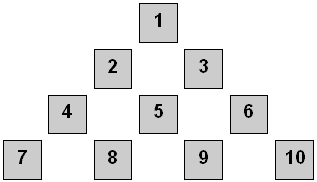Addition and Multiplication boxes
This task is about completing addition and multiplication equations using numbers 1-10

Complete each equation by filling in the boxes.
Use only the numbers above. Each number can be used more than once.
| a) | 9 | + |
 |
+ |
 |
= | 18 |
| b) |
 |
+ |
 |
+ | 5 | = | 22 |
| c) |
 |
+ | 8 | + |
 |
= | 27 |
| d) | 2 | × |
 |
× |
 |
= | 32 |
| e) |
 |
× | 3 | × |
 |
= | 36 |
| f) |
 |
× |
 |
× | 7 | = | 49 |

